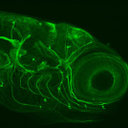Selective inhibition of JAK2/STAT1 signaling and iNOS expression mediates the anti-inflammatory effects of coniferyl aldehyde.
Raktažodžiai
Santrauka
Urgent needs still exist for selective control of excessive inflammation. Despite the therapeutic potential of natural compounds against inflammation-associated chronic conditions, lack of specific molecular targets renders these bioactive compounds difficult for further development. Here we examined the bioactivity of coniferyl aldehyde (CA), a natural phenolic compound found in several dietary substances and medicinal plants, elucidating its efficacy both in vivo and in vitro with underlying molecular mechanisms. IFN-γ/TNF-α-stimulated human keratinocytes and lipopolysaccharide (LPS)-stimulated murine macrophages were used to examine the effect of CA in vitro and to elucidate the underlying mechanisms. In vivo models of phorbol 12-myristate 13-acetate (TPA)-induced ear edema and carrageenan (CRG)-induced paw edema were employed to investigate the topical and systemic anti-inflammatory effects of CA, respectively. CA significantly reduced nitric oxide (NO) production and inducible nitric oxide synthase (iNOS) expression in LPS-stimulated macrophages. While nuclear factor-κB (NF-κB) and mitogen-activated protein kinase (MAPKs) pathways, the representative cellular pathways for iNOS induction, were not affected by CA, phosphorylation of Janus kinase 2 (JAK2) and signal Transducers and Activators of Transcription 1 (STAT1) and subsequent nuclear translocation of p-STAT1 were significantly decreased by CA. The effect of CA on JAK2-STAT1-iNOS axis was also observed in human keratinocytes stimulated with IFN-γ/TNF-α. Topical application of CA to mice produced significant protection against TPA-induced ear edema along with suppressed epidermal hyperproliferation and leucocyte infiltration. Systemic administration of CA significantly reduced CRG-induced paw edema in rats, where CRG-induced iNOS expression and STAT1 phosphorylation were decreased by CA. In summary, CA has significant anti-inflammatory properties both in vitro and in vivo, mediated by significant selective inhibition of JAK2-STAT1-iNOS signaling. CA is an attractive novel candidate for treating inflammatory diseases associated with excessive production of NO.



